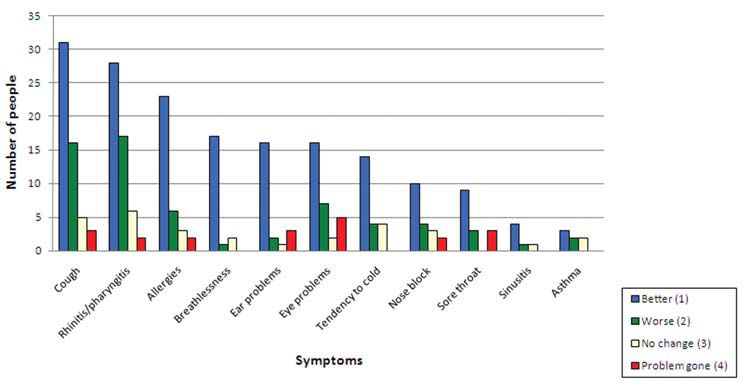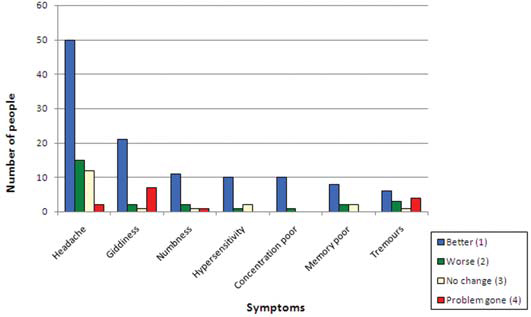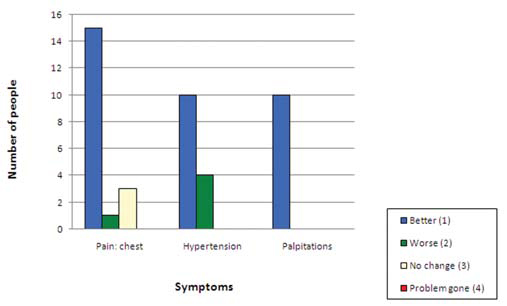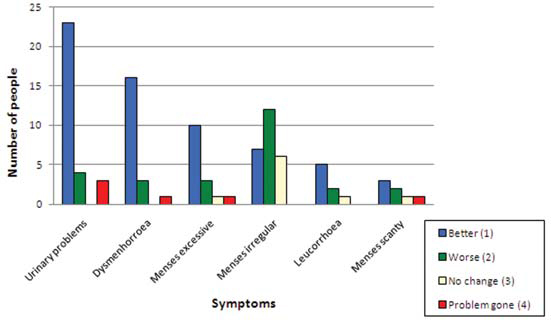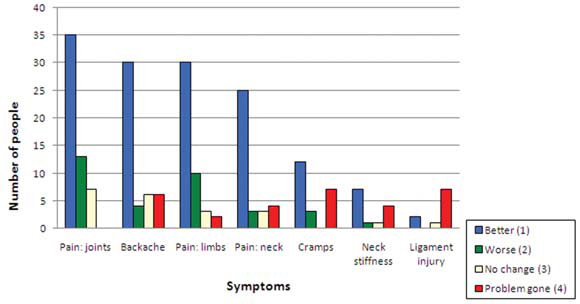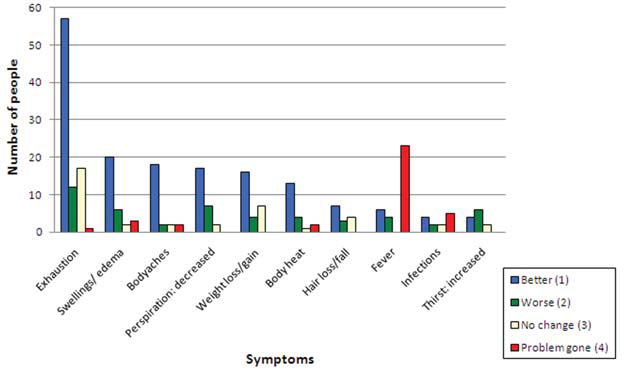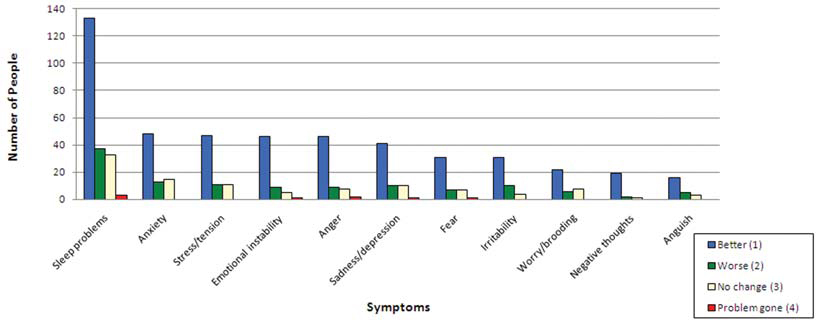Flower remedies
The effect of flower remedies on bodily symptoms
Abstract
This article discusses through statistical means, the effect of flower remedies on physical symptoms. The symptoms were deliberately not classified into disease diagnoses. This was done so that the study could be unbiased by a framework of disease classification. The cases were recorded by persons other than the treating physician from case files. An excel datasheet was created and analysed through npar (two-tailed binomial test; probability = 0.5) tests on each symptom recorded for these cases. This study showed that of a total of 2419 symptoms, 1,739 (72%) reported symptoms improved or resolved, whilst 680 (28%) reported symptoms showed no improvement or got worse. This distribution significantly differs from chance ( p< 0.001). This study indicates that significantly more people reported improved symptoms following flower treatment than those that did not.
Introduction
Medicines have been prepared with flowers from ancient times. In Āyurveda, there was a whole treatise on Puṣpāyurveda which has unfortunately been lost (1). In the West, flowers are used for therapeutic purposes chiefly in two ways: one for their fragrance, called aromatherapy which utilises the essential oils extracted from flowers; the other, developed by Edward Bach, is called the flower remedies which use the essence of the flower in water.
Bach made and used 38 flower remedies from flowers found in the British countryside. But now people all over the world are preparing remedies from indigenous flowers. So there are the Australian Bush essences, American flower remedies. The people working with these essences have been pioneers in their work and have mostly been intuitively guided in their use.
Basically there can be no systematisation of these remedies in mental terms of understanding. As Bach put it:
“They are able, like beautiful music or any glorious uplifting thing which gives us inspiration, to raise our very natures, and bring us nearer to our souls and by that very act to bring us peace and relieve our sufferings. They cure, not by attacking the disease, but by flooding our bodies with the beautiful vibrations of our Higher Nature, in the presence of which, disease melts away as snow in the sunshine.
There is no true healing unless there is a change in outlook, peace of mind, and inner happiness” (2).
The scientific world of today is shaped by certain assumptions. So anything therapeutic is also expected to fit into a set pattern. The most common assumption is that, “...there is only one sort of stuff, namely matter — the physical stuff of physics, chemistry, and physiology — and the mind is somehow nothing but a physical phenomenon (3).”
Thus we have a whole pharmacopoeia of drugs, their pharmacokinetics and pharmacodynamics. Active ingredients from gross natural products are extracted and used very effectively. However, modern pharmacologists themselves took their cue from herbs used in ancient systems of medicine, e.g. Sarpagandhā or Rauwolfia serpentina, which was used in Ăyurveda for a long time before being utilised as Reserpine by Woodward in the 1950s (4).
Ancient physicians were aware that matter was not the sole reality. They, through an inner sense or consciousness, could approach animate or inanimate objects and intuitively grasp their essential qualities. As put by Dr. Wills Harman in his book Global Mind Change, “Ultimately the reality behind the phenomenal world is contacted, not through the physical senses, but through deep intuition. Consciousness is not the end product of material evolution; rather, consciousness was here first!” (5)
This prescription of remedies has been mostly intuitive.
Rationale behind the study
This study was started 21 years ago with flower essences prepared from flowers growing in south India which had been seen and commented on by the Mother of the Sri Aurobindo Ashram. She said, “A flower is open to all that surrounds it: Nature, light, the rays of the sun, the wind, etc. It exerts a spontaneous influence on all that is around it. It radiates a joy and a beauty. It is frank: it hides nothing of its beauty, and lets it flow frankly out of itself. What is within, what is in its depths, it lets it come out so that everyone can see it.
It is equal: it has no preference. Everyone can enjoy its beauty and its perfume, without rivalry. It is equal and the same for everybody. There is no difference, or anything whatsoever. Then generous: without reserve or restriction, how it gives the mysterious beauty and the very own perfume of Nature. It sacrifices itself entirely for our pleasure, even its life it sacrifices to express this beauty and the secret of the things gathered within itself. And then, kind: it has such a tenderness, it is so sweet, so close to us, so loving. Its presence fills us with joy. It is always cheerful and happy.
Happy is he who can exchange his qualities with the real qualities of the flowers” (6).
So we decided to prepare essences of these flowers in water to see if these qualities could be transmitted to people having simple ailments. The ailments were deliberately not classified into disease diagnoses. This was done so that the study could be unbiased by a framework of disease classification.
Aim
To study the effect of flower remedies prepared at SAIIIHR on physical symptoms.
Materials and methods
Materials
Flower remedies (list at the end), 2,419 reported cases of bodily symptoms, Excel sheets for data recording, SPSS version 7.5 for analysis.
Methods
The cases were recorded by persons other than the treating physician from case files. An Excel datasheet was created and analysed through npar (two-tailed binomial test; probability = 0.5) tests on each symptom recorded for these cases.
Results
I. Overall effect of the flower essences
Following the use of flower treatment:
i. 1,568 (65%) reported cases of bodily symptoms improved;
ii. 397 (16%) became worse;
iii. 283 (12%) did not change;
iv. 171 (7%) had been completely resolved.
This is shown graphically in Figure 1.
As seen in the graph 1, the symptoms reported mostly, in descending order, were: low appetite, constipation, pain in the abdomen, flatulence, acidity, nausea and indigestion.
Other surprising physical complaints which were reported and helped were: worms, mouth ulcers, piles or hemorrhoids, gum problems and teeth problems.
The percentage of cases that became better and were cured (in descending order) are:
Indigestion 94.12
Pain on evacuation 90.91
Vomiting/nausea 88.24
Appetite: low 86.54
Diarrhoea 85.71
Pain: abdomen 80.43
Piles 77.78
Gum problems 77.78
Flatulence 76.74
Constipation 76.36
Teeth problems 75.00
Acidity 75.00
Worms 73.33
Mouth ulcers 72.73
Taste changed 71.43
Thirst: decreased 60.00
Liver problems 33.33
III. Effect of flower remedies on symptoms from the respiratory system, eye, ear, nose and throat
As expected, most people reported with symptoms like cough, rhinitis, pharyngitis and allergies. All these were helped by the flower remedies!
The percentage of cases that became better and were cured in descending order are:
Ear problems 86.36
Breathlessness 85
Sore throat 80
Allergies 73.53
Eye problems 70
Sinusitis 66.67
Tendency to colds 63.64
Blocked nose 63.16
Cough 61.82
Rhinitis/pharyngitis 56.6
Asthma 42.86
This is shown graphically in graph 2.
IV. Effect of flower remedies on symptoms of the skin
Complaints like rash, eruption, cracks were grouped under the heading of undiagnosed skin problems. Other complaints were: boils, discoloration, dryness of the skin, pimples and allergies.
The percentage of cases that became better and were cured (in descending order) are:
Boils 77.78
Skin: dry 75
Undiagnosed skin problems 74.36
Allergies 73.53
Skin discoloration 71.43
Pimples 69.23
This is shown graphically in graph 3.
V. Effect of flower remedies on symptoms from the nervous system
As expected, the most common presenting complaint in this category is headache followed by: giddiness, numbness, hyper-sensitivity, memory loss and poor con-centration. Surprisingly 4 out of 14 reports of tremours were cured!
The percentage of cases that became better and were cured (in descending order) are:
Concentration poor 90.91
Giddiness 90.32
Numbness 80
Hypersensitivity 76.92
Tremours 71.43
Memory poor 66.67
Headache 65.82
This is shown graphically in graph 4.
VI. Effect of flower remedies on symptoms from the cardiovascular system
The most commonly reported symptoms were pain in the chest (which could have other thans cardiac origin), hypertension and palpitations. All of them responded well to the flower remedies.
The percentage of cases that became better and were cured in (descending order) are:
Palpitations 100
Pain: chest 78.95
Hypertension 71.43
This is shown graphically in graph 5.
VII. Effect of flower remedies on symptoms from the genito-urinary and reproductive system
Here, the thing of note is that irregular menstruation became worse with the flower remedies!
The percentage of cases that became better and were cured (in descending order) are:
Urinary problems 86.67
Dysmenhorroea 85
Menses excessive 73.33
Menses scanty 66.67
Leucorrhoea 62.5
Menses irregular 28
This is shown graphically in graph 6.
VIII. Effect of flower remedies on symptoms from the skeletal system
Joint pains, backache, limb pains were expectedly the most common symptoms. The percentage of cases that became better and were cured in (descending order) are:
Ligament injury 90
Cramps 86.36
Neck stiffness 84.62
Pain: neck 82.86
Backache 78.26
Pain: limbs 71.11
Pain: joints 63.64
This is shown graphically in graph 7.
IX. Effect of flower remedies on general symptoms
Other most commonly reported symptoms
that did not fit into any particular system were taken as general. Exhaustion was the most commonly reported symptom here. Fever was the one in which the flowers seemed to have worked excellently (23 of the 33 times the fever was gone). This, however, may be due to the self-limiting nature of fever.
The percentage of cases that became better and were cured (in descending order) are:
Fever 87.88
Bodyaches 83.33
Body heat 75
Swellings/ oedema 74.19
Infections 69.23
Exhaustion 66.67
Perspiration: decreased 65.38
Weight loss/gain 59.26
Hair loss/fall 50
Thirst: increased 33.33
This is shown graphically in graph 8.
X. Effect of flower remedies on psychological symptoms
Though flower remedies were not prescribed on psychological grounds, it was surprising when the analysis showed a marked relief in the psychological states referred to in Graph 9.
The percentage of cases that became better and were cured in (descending order) are:
Negative thoughts 86.36
Emotional instability 77.05
Anger 73.85
Irritability 68.89
Stress/tension 68.12
Sadness/depression 67.74
Anguish 66.67
Sleep problems 66
Anxiety 63.16
Worry/brooding 61.11
Fear 57.89
In total, 1,739 (72%) reported symptoms were improved or resolved, whilst 680 (28%) reported symptoms showed no improvement or got worse. This distribution significantly differs from chance (two-tailed binomial test; probability = 0.5; p<0.001)
Table 1 shows the top 48 symptoms which responded to flower remedies. It is interesting to note that only 14 of the forty-eight top symptoms seem to be ‘psychological’ in nature or comprise a significant psychological component.
These symptoms may reflect the fact that these are the most common symptoms seen in a general population, and hence are the ones that appear at the top of the symptoms list. Another possible explanation is that people with these symptoms who sought flower treatment had already formulated some association that flower treatment would be of help for these specific problems.
Forty eight of the most common symptoms showed a distribution that significantly differed from chance. Specifically, more symptoms improved, following flower treatment, in comparison to the number of symptoms that did not improve.
Table 1 Top 48 symptoms that responded to flower remedies
(In descending order of most common)
| No. | Symptoms | Total No. N= 2,419 |
No. that improved / resolved N =1,739 (1,568+283) |
No. that did not improve/ worsened N = 680 (397+283) |
No. (%) N = 2,419 |
p value |
| 1. | Sleeplessness | 104 | 65 | 39 | 4.3 | 0.014 |
| 2. | Exhaustion | 87 | 58 | 29 | 3.6 | 0.003 |
| 3. | Headache | 79 | 52 | 27 | 3.27 | 0.007 |
| 4. | Anxiety | 76 | 48 | 28 | 3.14 | 0.029 |
| 5. | Stress/tension | 69 | 47 | 22 | 2.85 | 0.004 |
| 6. | Sleep unrefreshing | 68 | 46 | 22 | 2.81 | 0.005 |
| 7. | Anger | 65 | 48 | 17 | 2.69 | 0.000 |
| 8. | Sadness/depression | 62 | 43 | 19 | 2.56 | 0.003 |
| 9. | Emotional instability | 61 | 47 | 14 | 2.52 | 0.000 |
| 10. | Fear | 57 | 33 | 24 | 2.36 | 0.289 |
| 11. | Constipation | 55 | 42 | 13 | 2.27 | 0.000 |
| 12. | Cough | 55 | 34 | 21 | 2.27 | 0.106 |
| 13. | Pain: joints | 55 | 35 | 20 | 2.27 | 0.059 |
| 14. | Rhinitis/pharyngitis | 53 | 30 | 23 | 2.19 | 0.410 |
| 15. | Appetite: low | 52 | 45 | 7 | 2.15 | 0.000 |
| 16. | Backache | 46 | 36 | 10 | 1.9 | 0.000 |
| 17. | Pain: abdomen | 46 | 37 | 9 | 1.9 | 0.000 |
| 18. | Irritability | 45 | 31 | 14 | 1.86 | 0.017 |
| 19. | Pain: limbs | 45 | 32 | 13 | 1.86 | 0.007 |
| 20. | Flatulence | 43 | 33 | 10 | 1.78 | 0.001 |
| 21. | Skin problems | 39 | 29 | 10 | 1.61 | 0.004 |
| 22. | Worry/brooding | 36 | 22 | 14 | 1.49 | 0.243 |
| 23. | Diarrhoea | 35 | 30 | 5 | 1.45 | 0.000 |
| 24. | Pain: neck | 35 | 29 | 6 | 1.45 | 0.000 |
| 25. | Allergies | 34 | 25 | 9 | 1.41 | 0.010 |
| 26. | Vomiting/nausea | 34 | 30 | 4 | 1.41 | 0.000 |
| 27. | Fever | 34 | 29 | 5 | 1.41 | 0.000 |
| 28. | Acidity | 32 | 24 | 8 | 1.32 | 0.008 |
| 29. | Giddiness | 31 | 28 | 3 | 1.28 | 0.000 |
| 30. | Swellings/ oedema | 31 | 23 | 8 | 1.28 | 0.12 |
| 31. | Urinary problems | 30 | 26 | 4 | 1.24 | 0.000 |
| 32. | Eye problems | 30 | 21 | 9 | 1.24 | 0.045 |
| 33. | Weight loss/gain | 27 | 16 | 11 | 1.12 | 0.441 |
| 34. | Perspiration: decreased | 26 | 17 | 9 | 1.07 | 0.170 |
| 35. | Menses irregular | 25 | 7 | 18 | 1.03 | 0.043 |
| 36. | Anguish | 24 | 16 | 8 | 0.99 | 0.152 |
| 37. | Bodyaches | 24 | 20 | 4 | 0.99 | 0.002 |
| 38. | Tendency to cold | 22 | 14 | 8 | 0.91 | 0.286 |
| 39. | Negative thoughts | 22 | 19 | 3 | 0.91 | 0.001 |
| 40. | Ear problems | 22 | 19 | 3 | 0.91 | 0.001 |
| 41. | Cramps | 22 | 17 | 3 | 0.91 | 0.001 |
| 42. | Dysmenorrhoea | 20 | 17 | 3 | 0.83 | 0.003 |
| 43. | Thirst: decreased | 20 | 12 | 8 | 0.83 | 0.503 |
| 44. | Breathlessness | 20 | 17 | 3 | 0.83 | 0.003 |
| 45. | Body heat | 20 | 15 | 5 | 0.83 | 0.041 |
| 46. | Blocked nose | 19 | 12 | 7 | 0.79 | 0.019 |
| 47. | Pain: chest | 19 | 15 | 4 | 0.79 | 0.019 |
| 48. | Indigestion | 17 | 16 | 1 | 0.7 | 0.000 |
Probability score for top 48 symptoms by a two-tailed binomial test; probability = 0.5
Discussion
A Medline search reported 13 articles on flower remedies, mainly the Bach flower remedies. Most studies evaluated existing studies on Bach flower remedies. The closest studies to any physical effects were for pain relief and attention deficit hyperactive disorder. One study evaluated the therapeutic value beyond the placebo effect, and the potential of Bach flower remedies as a psychological method of pain relief (7). Another study, “Bach flower remedies used for attention deficit hyperactivity disorder in children—a prospective double blind controlled study” showed that there was no statistically significant difference between the effects of Bach flower remedies compared with placebo in the treatment of children with ADHD (8). No other studies were found on the ‘physical’ or bodily effects of flower remedies.
This study indicates that significantly more people reported improved symptoms following flower treatment than those that did not. This is in general when all symptoms are considered together.
Symptoms that responded best to flower remedies were: indigestion, cramps, ear problems, urinary problems, giddiness, fever, vomiting/nausea, pain: neck, diarrhoea, flatulence, breathlessness, dysmeorrhoea, bodyaches, skin problems, appetite: low, sleep problems, stress, exhaustion, backache, pain in the abdomen, constipation, negative thoughts, anger, emotional instability, sadness/depression and unrefreshing sleep.
For the ‘menses irregular’ symptom, significantly more cases did not improve compared to those that did improve.
As this study is an analysis of observations and not a planned RCT (randomised clinical trial), the following questions cannot be answered effectively:
• Would people have improved irrespective of the treatment?
• Are individuals taking other treatment in addition to the flower treatment?
• Would a placebo treatment have given the same results? For example, if individuals were given water/juice but informed it was a flower treatment or that it was a treatment, would that have helped their symptoms?
• What is the role of expectation and motivation? What is the role of their percep-tions of: (1) the physician; (2) their own beliefs about the cause of their symptoms?
• Some symptoms are self-limiting. For example, fever is going to resolve in most people eventually.
• The data is categorical and does not inform us on the extent to which the symptoms improved or got worse (i.e. by how much). This is important to deduce the actual effect size of such a treatment.
• General descriptives: average length of treatment; number of people treated; number of people with multiple symptoms; age/sex of patients; list of other treatments they have used still needs to be evaluated.
• The average length of time for each treatment. Do certain symptoms take longer to treat? Does the length of time for a treatment relate to the outcome?
• The relationship between the type of flower treatment and symptom.
Conclusion
This study aims to open up a new possibility for patients who are not satisfied with their treatment through other systems of medicine. This also adds to the armamentarium of the treating physician who is constrained by the limitations of his system. Hence flower remedies can complement well with the mainstream as well as other therapeutic measures. However, more controlled and well-planned studies and critical analysis of the results are necessary to establish the credentials of this beautiful therapeutic intervention.
References
1. Sharma PV. Pushpaayurvedah. Varanasi: Chaukhambha Visvabharati; 1997, Preface.
2. Scheffer M. Bach Flower Therapy — theory and practice. New Delhi: B. Jain Publishers; 1991, p. 13.
3. Dennet DC. Consciousness Explained. Boston; Little, Brown and Company, 1991, p. 33.
4. Goodman Gilman A, Rall T, Nies AS, Palmer T. The Pharmacological Basis of Therapeutics. Singapore; Pergamon Press, Inc., 1991, p. 386.
5. Brennan, B. A. Light Emerging. USA; Bantam Books, 1993, pp. 31-2.
6. Flowers and Fragrance, Part 2. Pondicherry: Sri Aurobindo Society; 1979, pp.50-1.
7. Howard J. Do Bach flower remedies have a role to play in pain control? A critical analysis investigating therapeutic value beyond the placebo effect, and the potential of Bach flower remedies as a psychological method of pain relief. Complement Ther Clin Pract. August, 2007; Aug.13(3):174-83.
8. Pintov, S, Hochman M, Livne A, Heyman E, Lahat E. Bach flower remedies used for attention deficit hyperactivity disorder in children—a prospective double blind controlled study. Eur J Paediatr Neurol. 2005; 9(6):395-8.
Appendix
List of flower remedies used in the study
1. Eucalyptus
2. Nelumbo nucifera ‘Alba’
3. Cordia Sebestena
4. Hibiscus (salmon pink, red veins and red centre)
5. Hymenocallis
6. Hibiscus (pale cream yellow with red centre)
7. Nyctanthes arbor-tristis
8. Vernonia eleagnaefolia
9. Duranta repens
10. Eranthemum pulchellum
11. Ixora singaporensis (orange)
12. Turnera ulmifolia elegans
13. Nelumbo nucifera (pink)
14. Begonia
15. Hibiscus Hawaiian large single (Salmon pink with pink centre)
16. Hibiscus Hawaiian medium to large
17. Single orange with smooth or ruffled petals, centre of various colours
18. Erythrina variegata
19. Hibiscus Hawaiian large semi-double yellow, with fire red and orange centre
20. Helianthus
21. Coreopsis
22. Pseudocalymna alliaceum
23. Euphorbia milii
24. Ipomoea alba
25. Dombeya
26. Hibiscus
27. Helianthus
28. Calatropis
29. Rosa chinensis ‘Minima’
30. Ipomoea cairica
31. Kopsia fruiticosa
32. Ocimum sanctum
33. Ocimum basilicum
34. Bougainvillae light lavender
35. Hibiscus mutabilis
36. Punica granatum
37. Brownea coccinea
38. Michaelia champaca ‘alba’
39. Malvaviscus arboreus
40. Cleodendrum minahassae
41. Cleodendrum indicum
42. Aloe barbadensis
43. Hibiscus ‘rosa-sinensis’
44. Porana paniculata
45. Hibiscus albo-variegata
46. Quisqualis indica
47. Solanum torvum
48. Poinciana pulcherrima
49. Plumbago zeylanica
50. Tribulus terrestris
51. Jatropha podagarica
52. Gerbera jamesonii
53. Impatiens balsamina
54. Nymphaea (yellow)
55. Bauhinia tomentosa
56. Lobularia maritime
57. Ravenia spectabilis
58. Thespesia populnea
59. Jacquemontia pentantha
60. Sporobolus capillaris
61. Cassia fistula
62. Calotropis white
63. Zinnia
64. Clerodendrum fragrans
65. Operculina turpethum
66. Antigonon ‘album’
67. Gomphrena globosa
68. Thunbergia erecta
69. Zephyranthes
70. Catharanthus roseus
71. Bougainvillea (white)
72. Helianthus
73. Lagerstroemia
74. Speciosa
75. Klienhovia hospita
76. Sansevieria
77. Ocimum basilicum
78. Callistemon
79. Thunbergia grandiflora
80. Ruellia ciliosa
81. Torenia fournieri
82. Chrysanthemum morifolium
83. Cestrum diurnum
84. Eucharis grandiflora
85. Rosa
86. Calandrinia grandiflora
87. Hamelia patens
88. Tristellateia australis
89. Thymophylla tenuiloba
90. Memecylon tinctorium
91. Castanospermum australe
92. Pereskia
93. Polianthes tuberosa
94. Thunbergia alata
95. Senecio
96. Thunbergia kirkii
97. Plumbago indica
98. Mimusops elengi
99. Portlandia grandiflora
100. Ixora thwaitesii (white)
101. Guettarda speciosa
102. Callophyllum inophyllum
103. Murraya paniculata
104. Gardenia jasminoides
105. Tagetes
106. Passiflora
107. Hibiscus Hawaiian single large bright orange red
108. Tecomaria carpensis
109. Codiaeum
110. Couroupita guianensis
111. Erythrina variegate ‘alba’
112. Hollarrhena antidysenterica
113. Hibiscus pink single
114. Vallaris solanacea
115. Plumeria rubra
116. Anthurium andreanum
117. Jasminum
118. Pimpinella major
119. Lantana (white)
120. Thunbergia fragrans
121. Nerium oleander (white)
122. Clitoria ternatea + Quamoclit pennata
123. Pavetta indica
124. Gardenia jasminoides
125. Strophanthus gratus
126. Gladious hortulanus
127. Gliricidia sepium
128. Lobelia erinus
129. Tecoma grandis
130. Angelonia (white with purple dots)
131. Angelonia grandiflora
132. Brunfelsia americana
133. Clerodendrum splendens
134. Hedychium
135. Solanum seaforthianum
136. Peltophorum pterocarpum
137. Passiflora caerulea
138. Phlox drummondii
139. Citharexylum
140. Stachy tarpheta
141. Azadirachta indica
142. Pelargonium hortorum
143. Petrea volublis
144. Asparagus densiflorus
145. Portulaca grandiflora
146. Bauhinia purpurea
147. Barringtonia speciosa/asiatica
148. Cosmos
149. Michelia champaca
150. Nerium oleander (double pink)
151. Nerium oleander (single pink)
152. Datura (violet)
153. Rosa chinensis
154. Cosmos (white)
155. Millingtonia hortensis
156. Capparis brevispina
157. Asystasia
158. Nerium oleander (single crimson)
159. Beaumontia jerdoniana
160. Allamanda cathartica
161. Hibiscus mutabilis ‘rosa’
162. Solanum trilobatum
163. Graptophyllum
164. Bignonia purpurea
165. Ageratum houstonianum
166. Duranta repens ‘alba’
167. Mimosa pudica
168. Anemopaegma chamberlaynii
169. Verbena tenuisecta
170. Saraca indica
171. Acacia auriculiformis
Dr. Vandana, who is now practising at the Healing Center near Auroville, has been working with many flowers, to which the Mother gave spiritual significances, for the last 25 years.
Share with us (Comments,contributions,opinions)
When reproducing this feature, please credit NAMAH,and give the byline. Please send us cuttings.

 Flower remedies
Flower remedies

